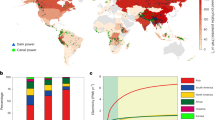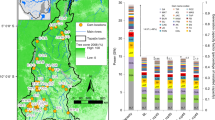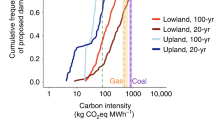Abstract
Vast hydropower resources remain untapped globally, the deployment of which could provide energy-economic benefits but negatively impact riverine ecosystems. Across eco-sensitive river basins, it is unclear how drivers of hydropower expansion, such as rapid economic growth and a low-carbon energy transition, could interact with countervailing forces, such as increasingly cost-competitive variable renewable energy (VRE). Using an integrated energy–water–economy model, we explore the effects of these forces on long-term hydropower expansion in the world’s 20 most eco-sensitive basins, which have high ecological richness and untapped hydropower potential. We find that a low-carbon transition exerts the strongest development pressure, causing deployment exceeding 80% of exploitable potential in more than 72% of eco-sensitive basins by 2050, most of which have limited deployment today. Rapid economic growth induces such extensive deployment in only 44% of eco-sensitive basins. Enhanced integration of VRE reduces deployment, alleviating the impacts of rapid economic growth but not the low-carbon transition. Our findings will help to navigate sustainable hydropower development considering both energy-economic and eco-conservation goals.
This is a preview of subscription content, access via your institution
Access options
Access Nature and 54 other Nature Portfolio journals
Get Nature+, our best-value online-access subscription
$29.99 / 30 days
cancel any time
Subscribe to this journal
Receive 12 digital issues and online access to articles
$119.00 per year
only $9.92 per issue
Buy this article
- Purchase on Springer Link
- Instant access to full article PDF
Prices may be subject to local taxes which are calculated during checkout




Similar content being viewed by others
Data availability
The data used and generated in this study are available on Zenodo at https://doi.org/10.5281/zenodo.8008401. The data include a shapefile of the GCAM’s basin-regions, GCAM outputs of electricity generation for each of the eight scenarios and basin-scale untapped hydropower potential, planned hydropower capacity, fish richness and annual fish catch.
Code availability
The Python codes (in Jupyter Notebooks v.6.4.8 with Python 3.8) with relevant instructions to reproduce our analysis and results are available on GitHub at https://github.com/kamal0013/chowdhury-etal_2023_hydropower. The GCAM model is available at https://zenodo.org/records/8231148.
References
Almeida, R. M. et al. Strategic planning of hydropower development: balancing benefits and socioenvironmental costs. Curr. Opin. Environ. Sustain. 56, 101175 (2022).
The Changing Role of Hydropower: Challenges and Opportunities Technical Report (IRENA, 2023).
World Register of Dams (ICOLD, 2020).
Zhou, Y. et al. A comprehensive view of global potential for hydro-generated electricity. Energy Environ. Sci. 8, 2622–2633 (2015).
Xu, R. et al. A global-scale framework for hydropower development incorporating strict environmental constraints. Nat. Water 1, 113–122 (2023).
Jacobson, M. Z. et al. Low-cost solutions to global warming, air pollution, and energy insecurity for 145 countries. Energy Environ. Sci. 15, 3343–3359 (2022).
Cáceres, A. L., Jaramillo, P., Matthews, H. S., Samaras, C. & Nijssen, B. Potential hydropower contribution to mitigate climate risk and build resilience in Africa. Nat. Clim. Change 12, 719–727 (2022).
Grill, G. et al. Mapping the world’s free-flowing rivers. Nature 569, 215–221 (2019).
Zarfl, C. et al. Future large hydropower dams impact global freshwater megafauna. Sci. Rep. 9, 18531 (2019).
Fan, P. et al. Recently constructed hydropower dams were associated with reduced economic production, population, and greenness in nearby areas. Proc. Natl Acad. Sci. USA 119, e2108038119 (2022).
Zarfl, C., Lumsdon, A. E., Berlekamp, J., Tydecks, L. & Tockner, K. A global boom in hydropower dam construction. Aquat. Sci. 77, 161–170 (2015).
Ziv, G., Baran, E., Nam, S., Rodríguez-Iturbe, I. & Levin, S. A. Trading-off fish biodiversity, food security, and hydropower in the Mekong River Basin. Proc. Natl Acad. Sci. USA 109, 5609–5614 (2012).
Flecker, A. S. et al. Reducing adverse impacts of Amazon hydropower expansion. Science 375, 753–760 (2022).
Winemiller, K. O. et al. Balancing hydropower and biodiversity in the Amazon, Congo, and Mekong. Science https://doi.org/10.1126/science.aac7082 (2016).
Barbarossa, V. et al. Impacts of current and future large dams on the geographic range connectivity of freshwater fish worldwide. Proc. Natl Acad. Sci. USA 117, 3648–3655 (2020).
Net Zero by 2050 – A Roadmap for the Global Energy Sector Technical Report (IEA, 2021).
Zhang, Y. et al. Long-term basin-scale hydropower expansion under alternative scenarios in a global multisector model. Environ. Res. Lett. 17, 114029 (2022).
Schmitt, R. J. P., Kittner, N., Kondolf, G. M. & Kammen, D. M. Deploy diverse renewables to save tropical rivers. Nature 569, 330–332 (2019).
Waldman, J., Sharma, S., Afshari, S. & Fekete, B. Solar-power replacement as a solution for hydropower foregone in US dam removals. Nat. Sustain. 2, 872–878 (2019).
Almeida, R. M. et al. Floating solar power could help fight climate change – let’s get it right. Nature 606, 246–249 (2022).
Gonzalez, J. M. et al. Designing diversified renewable energy systems to balance multisector performance. Nat. Sustain. 6, 415–427 (2023).
Siala, K., Chowdhury, A. K., Dang, T. & Galelli, S. Solar energy and regional coordination as a feasible alternative to large hydropower in Southeast Asia. Nat. Commun. 12, 4159 (2021).
Schmitt, R. J. P., Kittner, N., Kondolf, G. M. & Kammen, D. M. Joint strategic energy and river basin planning to reduce dam impacts on rivers in Myanmar. Environ. Res. Lett. 16, 054054 (2021).
Chowdhury, A. F. M. K. et al. Enabling a low-carbon electricity system for Southern Africa. Joule 6, 1826–1844 (2022).
de Faria, F. A. M. & Jaramillo, P. The future of power generation in Brazil: an analysis of alternatives to Amazonian hydropower development. Energy Sustain. Dev. 41, 24–35 (2017).
Opperman, J. J. et al. Balancing renewable energy and river resources by moving from individual assessments of hydropower projects to energy system planning. Front. Environ. Sci. https://doi.org/10.3389/fenvs.2022.1036653 (2023).
Calvin, K. et al. GCAM v5.1: representing the linkages between energy, water, land, climate, and economic systems. Geosci. Model Dev. 12, 677–698 (2019).
van Vuuren, D. P. et al. The Shared Socio-economic Pathways: trajectories for human development and global environmental change. Glob. Environ. Change 42, 148–152 (2017).
Vimmerstedt, L. et al. 2021 Annual Technology Baseline (ATB) Cost and Performance Data for Electricity Generation Technologies (National Renewable Energy Laboratory, 2021).
Schmitt, R. J. P., Bizzi, S., Castelletti, A., Opperman, J. J. & Kondolf, G. M. Planning dam portfolios for low sediment trapping shows limits for sustainable hydropower in the Mekong. Sci. Adv. 5, eaaw2175 (2019).
Galelli, S., Dang, T. D., Ng, J. Y., Chowdhury, A. F. M. K. & Arias, M. E. Opportunities to curb hydrological alterations via dam re-operation in the Mekong. Nat. Sustain. 5, 1058–1069 (2022).
World Energy Outlook 2021 Technical Report (IEA, 2021).
International Energy Outlook 2021 Technical Report https://www.eia.gov/outlooks/ieo/index.php (US Energy Information Administration, 2021).
SAPP Pool Plan 2017 Technical Report (Southern African Power Pool, 2017).
Gleick, P. H. Transitions to freshwater sustainability. Proc. Natl Acad. Sci. USA 115, 8863–8871 (2018).
Almeida, R. M. et al. Reducing greenhouse gas emissions of Amazon hydropower with strategic dam planning. Nat. Commun. 10, 4281 (2019).
The State of Food Security and Nutrition in the World 2021 (FAO, IFAD, UNICEF, WFP and WHO, 2021).
Zeng, R., Cai, X., Ringler, C. & Zhu, T. Hydropower versus irrigation – an analysis of global patterns. Environ. Res. Lett. 12, 034006 (2017)
Murshed, S. B. & Kaluarachchi, J. J. Scarcity of fresh water resources in the Ganges Delta of Bangladesh. Water Secur. 4–5, 8–18 (2018).
Shamsudduha, M. et al. The Bengal Water Machine: Quantified freshwater capture in Bangladesh. Science 377, 1315–1319 (2022).
Chaudhari, S. et al. In-stream turbines for rethinking hydropower development in the Amazon basin. Nat. Sustain. 4, 680–687 (2021).
Kuriqi, A., Pinheiro, A. N., Sordo-Ward, A., Bejarano, M. D. & Garrote, L. Ecological impacts of run-of-river hydropower plants – current status and future prospects on the brink of energy transition. Renew. Sustain. Energy Rev. 142, 110833 (2021).
Hunt, J. D. et al. Global resource potential of seasonal pumped hydropower storage for energy and water storage. Nat. Commun. 11, 947 (2020).
Schomberg, A. C., Bringezu, S., Flörke, M. & Biederbick, H. Spatially explicit life cycle assessments reveal hotspots of environmental impacts from renewable electricity generation. Commun. Earth Environ. 3, 197 (2022).
Wild, T. B., Reed, P. M., Loucks, D. P., Mallen-Cooper, M. & Jensen, E. D. Balancing hydropower development and ecological impacts in the Mekong: tradeoffs for Sambor Mega Dam. J. Water Resour. Plan. Manage. 145, 05018019 (2019).
Vinca, A. et al. Transboundary cooperation a potential route to sustainable development in the Indus basin. Nat. Sustain. 4, 331–339 (2021).
Guo, F. et al. Implications of intercontinental renewable electricity trade for energy systems and emissions. Nat. Energy 7, 1144–1156 (2022).
van Vliet, M. T. H., Wiberg, D., Leduc, S. & Riahi, K. Power-generation system vulnerability and adaptation to changes in climate and water resources. Nat. Clim. Change 6, 375–380 (2016).
Kondolf, G. M. et al. Sustainable sediment management in reservoirs and regulated rivers: experiences from five continents. Earths Future 2, 256–280 (2014).
Carlino, A. et al. Declining cost of renewables and climate change curb the need for African hydropower expansion. Science 381, eadf5848 (2023).
Gernaat, D. E. H. J. et al. Climate change impacts on renewable energy supply. Nat. Clim. Change 11, 119–125 (2021).
Turner, S. W. D., Voisin, N., Nelson, K. & Tidwell, V. Drought Impacts on Hydroelectric Power Generation in the Western United States – A Multiregional Analysis of 21st Century Hydropower Generation Technical Report (US Pacific Northwest National Lab, 2022).
Santos da Silva, S. R. et al. Power sector investment implications of climate impacts on renewable resources in Latin America and the Caribbean. Nat. Commun. 12, 1276 (2021).
Turner, S. W. D., Voisin, N., Fazio, J., Hua, D. & Jourabchi, M. Compound climate events transform electrical power shortfall risk in the Pacific Northwest. Nat. Commun. 10, 8 (2019).
Lamontagne, J. R. et al. Large ensemble analytic framework for consequence-driven discovery of climate change scenarios. Earths Future 6, 488–504 (2018).
Gernaat, D. E. H. J., Bogaart, P. W., Vuuren, D. P. V., Biemans, H. & Niessink, R. High-resolution assessment of global technical and economic hydropower potential. Nat. Energy 2, 821–828 (2017).
Garrett, K., McManamay, R. A. & Wang, J. Global hydropower expansion without building new dams. Environ. Res. Lett. 16, 114029 (2021).
Oberdorff, T. et al. Global and regional patterns in riverine fish species richness: a review. Int. J. Ecol. 2011, e967631 (2011).
McIntyre, P. B., Reidy Liermann, C. A. & Revenga, C. Linking freshwater fishery management to global food security and biodiversity conservation. Proc. Natl Acad. Sci. USA 113, 12880–12885 (2016).
Clarke, J. F. & Edmonds, J. A. Modelling energy technologies in a competitive market. Energy Econ. 15, 123–129 (1993).
Brinkerink, M. & Deane, P. PLEXOS-World 2015 (Harvard Dataverse, 2021); https://dataverse.harvard.edu/dataset.xhtml?persistentId=doi:10.7910/DVN/CBYXBY
Huppmann, D. et al. IAMC 1.5 °C Scenario Explorer and Data hosted by IIASA (Integrated Assessment Modeling Consortium, International Institute for Applied Systems Analysis, 2018); https://data.ene.iiasa.ac.at/DOI/SR15/08-2018.15429/
Moran, E. F., Lopez, M. C., Moore, N., Müller, N. & Hyndman, D. W. Sustainable hydropower in the 21st century. Proc. Natl Acad. Sci. USA 115, 11891–11898 (2018).
Muratori, M. et al. Cost of power or power of cost: a U.S. modeling perspective. Renew. Sustain. Energy Rev. 77, 861–874 (2017).
Acknowledgements
This research was supported by the US Department of Energy, Office of Science, as part of research in Multi-Sector Dynamics, Earth and Environmental System Modeling Program (contract number DE-AC05-76RL01830). The views and opinions expressed in this paper are those of the authors alone.
Author information
Authors and Affiliations
Contributions
A.F.M.K.C. and T.W. conceptualized the study; A.F.M.K.C. and Y.Z. ran the GCAM scenarios; A.F.M.K.C. conducted the analysis and visualization; A.F.M.K.C. and T.W. wrote the first draft; and A.F.M.K.C., T.W., Y.Z., M.B., G.I., S.H.K. and J.L. edited the paper.
Corresponding author
Ethics declarations
Competing interests
The authors declare no competing interests.
Peer review
Peer review information
Nature Sustainability thanks Noah Kittner, Jeffrey Opperman and the other, anonymous, reviewer(s) for their contribution to the peer review of this work.
Additional information
Publisher’s note Springer Nature remains neutral with regard to jurisdictional claims in published maps and institutional affiliations.
Supplementary information
Supplementary Information
Supplementary Texts 1 and 2, Figs. 1–16, Tables 1–6 and the references cited in the Supplementary Information file.
Rights and permissions
Springer Nature or its licensor (e.g. a society or other partner) holds exclusive rights to this article under a publishing agreement with the author(s) or other rightsholder(s); author self-archiving of the accepted manuscript version of this article is solely governed by the terms of such publishing agreement and applicable law.
About this article
Cite this article
Chowdhury, A.F.M.K., Wild, T., Zhang, Y. et al. Hydropower expansion in eco-sensitive river basins under global energy-economic change. Nat Sustain 7, 213–222 (2024). https://doi.org/10.1038/s41893-023-01260-z
Received:
Accepted:
Published:
Issue Date:
DOI: https://doi.org/10.1038/s41893-023-01260-z
This article is cited by
-
Trading rivers for hydropower
Nature Sustainability (2024)



